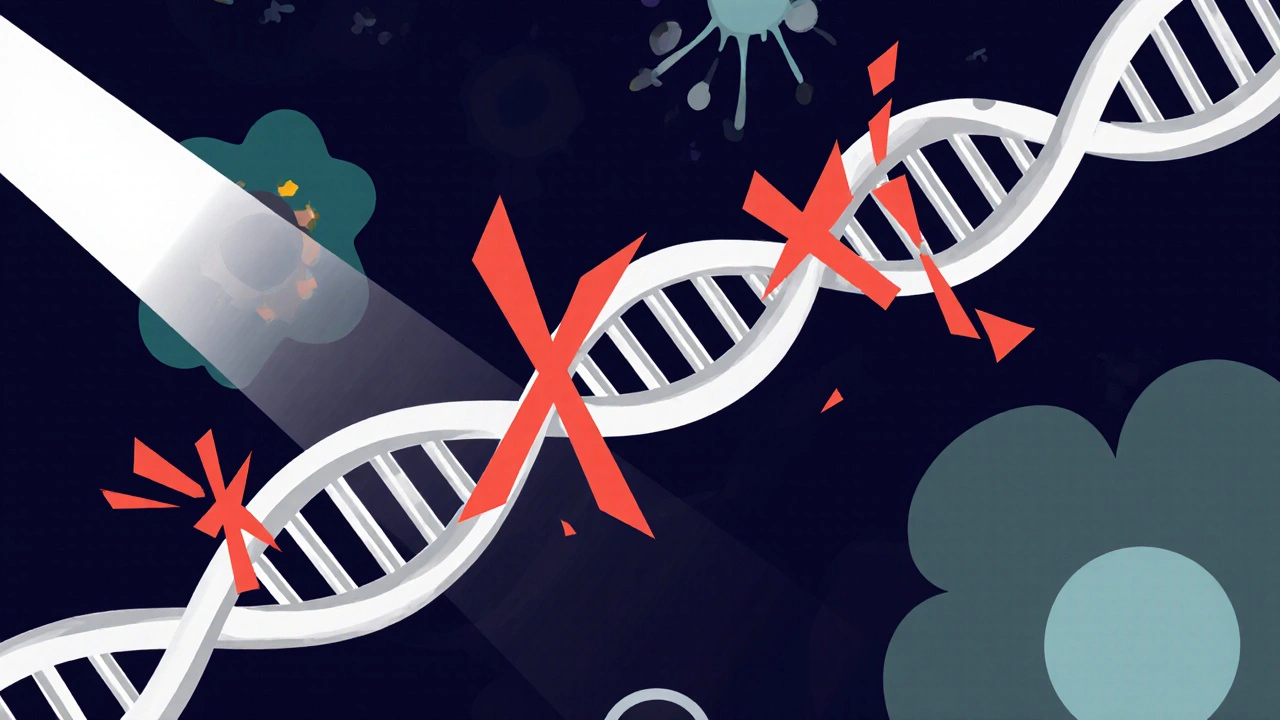Chemotherapy Drug Comparison Tool
Compare Chemotherapy Drugs
Select the drugs you want to compare and view key differences in effectiveness, side effects, and costs for cancer treatment.
Comparison Results
| Side Effects | Cost per Cycle | Best For | Key Considerations | |
|---|---|---|---|---|
|
Alkeran (Melphalan)
FDA-approved for multiple myeloma & ovarian cancer |
High bone marrow suppression Moderate nausea/vomiting Low renal risk |
$8,400 | Multiple myeloma High-dose regimens before transplant |
Best for transplant-eligible patients Requires growth factor support |
|
Cyclophosphamide
Used in breast cancer, lymphoma |
Moderate bone marrow suppression Low-moderate GI toxicity Low renal risk |
$1,000 | Breast cancer Autoimmune disorders |
Milder toxicity at standard doses Can cause hair loss & infertility |
|
Ifosfamide
Used in sarcoma & testicular cancer |
Moderate-high bone marrow suppression Moderate GI toxicity High urological risk (hemorrhagic cystitis) |
$3,900 | Sarcoma Testicular cancer |
Requires MESNA protection Neurotoxicity at high doses |
|
Busulfan
Used in CML & bone marrow conditioning |
High bone marrow suppression Low GI toxicity Low renal risk |
$2,000 | Chronic myeloid leukemia (CML) Stem cell transplant conditioning |
Prolonged thrombocytopenia Rare pulmonary fibrosis |
|
Cisplatin
Used in head/neck, lung, bladder cancer |
Moderate bone marrow suppression Moderate GI toxicity High renal risk Peripheral neuropathy |
$1,800 | Head/neck cancer Lung cancer Bladder cancer |
Platinum-sensitive tumors Nephrotoxicity requires hydration |
When doctors face a cancer that needs an alkylating agent, the choice of drug can change the outcome dramatically. Alkeran is a nitrogen‑mustard chemotherapy whose generic name is melphalan, approved for multiple myeloma and certain ovarian cancers. Yet many oncologists also consider drugs like cyclophosphamide, ifosfamide, busulfan, or cisplatin for similar indications. This guide breaks down how Alkeran stacks up against those alternatives, so you can understand the trade‑offs before a treatment plan is set.
Quick Takeaways
- Alkeran works by cross‑linking DNA, causing tumor cells to die; it’s especially potent in multiple myeloma.
- Key alternatives differ in administration route, toxicity profile, and cost.
- When bone‑marrow suppression is a concern, cyclophosphamide or low‑dose ifosfamide may be gentler.
- For patients with renal impairment, cisplatin is riskier than Alkeran.
- Guideline‑driven selection (NCCN, ESMO) ties drug choice to tumor type, prior therapy, and fitness level.
How Alkeran Works - Mechanism & Pharmacology
Alkeran belongs to the class of alkylating agents known as nitrogen mustards. Once inside the bloodstream, melphalan forms highly reactive ethyleneimine intermediates that attach alkyl groups to the N7 position of guanine in DNA. This creates cross‑links between DNA strands, blocking replication and triggering apoptosis in rapidly dividing cells. The drug is administered intravenously or orally (as a powder for suspension), achieving peak plasma concentrations within 30 minutes of infusion. Its half‑life is roughly 90 minutes, but intracellular binding makes the anti‑cancer effect last much longer.
Key Clinical Uses of Alkeran
Regulatory approvals focus on two disease areas:
- Multiple myeloma - often used in high‑dose regimens before autologous stem‑cell transplant.
- Ovarian cancer - combined with platinum agents for recurrent disease.
Off‑label use also appears in certain breast‑cancer protocols and neuroblastoma, but those settings rely heavily on physician experience and trial data.

Major Alternatives - Who They Are and When They Shine
Below is a snapshot of the most common alkylating or DNA‑damaging agents that compete with Alkeran in practice.
- Cyclophosphamide - a pro‑drug activated in the liver; useful for breast, lymphoma, and autoimmune disorders.
- Ifosfamide - similar to cyclophosphamide but with a higher urotoxic risk; favored in sarcoma and testicular cancer.
- Busulfan - a pure alkylating agent with a long history in chronic myeloid leukemia (CML) and bone‑marrow conditioning.
- Cisplatin - a platinum‑based DNA cross‑linker; backbone of many head‑and‑neck, lung, and bladder cancer regimens.
- Doxorubicin - an anthracycline that intercalates DNA; often paired with alkylators for synergistic effect.
Side‑Effect Profiles - What to Expect
All chemo drugs hit fast‑dividing cells, but the patterns differ:
| Drug | Bone‑Marrow Suppression | Gastrointestinal Toxicity | Renal / Urological Risk | Other Notable Toxicities |
|---|---|---|---|---|
| Alkeran (Melphalan) | High - neutropenia common | Moderate - nausea/vomiting | Low - rare nephrotoxicity | Secondary malignancies (rare), mucositis |
| Cyclophosphamide | Moderate - dose‑dependent | Low‑moderate | Low - occasional hematuria | Hair loss, infertility |
| Ifosfamide | Moderate‑high | Moderate | High - hemorrhagic cystitis (needs MESNA) | Neurotoxicity at high doses |
| Busulfan | High - prolonged thrombocytopenia | Low | Low | Pulmonary fibrosis (rare) |
| Cisplatin | Moderate | Moderate | High - nephrotoxicity, ototoxicity | Peripheral neuropathy |
Cost Considerations - Real‑World Pricing (US, 2025)
Insurance coverage varies, but average wholesale price (AWP) per treatment cycle gives a practical sense of out‑of‑pocket exposure:
- Alkeran: $4,200 per 140 mg vial (IV) - typical 2‑cycle high‑dose protocol ≈ $8,400.
- Cyclophosphamide: $250 per 1 g vial - common 4‑week regimen ≈ $1,000.
- Ifosfamide: $650 per 1 g vial - multi‑day infusion ≈ $3,900 for a 6‑day course.
- Busulfan: $500 per 6 mg tablet - conditioning regimen ≈ $2,000.
- Cisplatin: $300 per 100 mg vial - 6‑cycle schedule ≈ $1,800.
High‑dose Alkeran can stress budgets, but many centers bundle the drug with stem‑cell harvest fees, which can offset total cost when a transplant is planned.
Decision Criteria - When to Choose Alkeran Over Others
Oncologists weigh several factors:
- Tumor biology: Multiple myeloma responds best to alkylator‑based high‑dose regimens; Alkeran’s DNA cross‑linking is especially lethal to plasma cells.
- Prior therapy: If a patient already received cyclophosphamide, adding Alkeran can provide a non‑cross‑resistant mechanism.
- Patient fitness: Younger, transplant‑eligible patients tolerate the intense marrow suppression of Alkeran better than older patients who may need milder agents.
- Organ function: Normal renal function favors Alkeran; severe kidney disease pushes clinicians toward cyclophosphamide or ifosfamide with protective measures.
- Cost & insurance: When coverage limits high‑dose agents, cyclophosphamide becomes the fallback.
Guideline committees (NCCN 2025) embed these considerations in algorithm charts, highlighting Alkeran as a Category 1 recommendation for transplant‑eligible myeloma.
Practical Checklist for Clinicians
- Confirm diagnosis and disease stage (myeloma, ovarian, etc.).
- Order baseline labs: CBC, renal & hepatic panels, fertility assessment.
- Review prior chemotherapy exposure - avoid overlapping toxicities.
- Discuss high‑dose Alkeran with patient: expected side effects, need for growth‑factor support, possible stem‑cell collection.
- Arrange supportive meds: anti‑emetics, mesna (if using ifosfamide), renal hydration protocol for cisplatin.
- Document consent and insurance pre‑auth before ordering the drug.
Frequently Asked Questions
What cancers is Alkeran officially approved for?
In the United States, the FDA lists Alkeran for multiple myeloma (often as part of high‑dose therapy before stem‑cell transplant) and for ovarian cancer when used with a platinum agent in recurrent disease.
How does the toxicity of Alkeran compare to cyclophosphamide?
Both drugs suppress bone marrow, but Alkeran typically causes deeper neutropenia and more severe mucositis because it creates tighter DNA cross‑links. Cyclophosphamide’s side effects are milder at standard doses, though high‑dose regimens can approach Alkeran’s toxicity.
Can Alkeran be given orally?
Yes, melphalan is available as a powder for suspension that patients can swallow. Oral bioavailability is lower than IV, so dosing is adjusted (typically 0.25‑0.5 mg/kg oral versus 0.25 mg/kg IV). The oral route is used mainly for maintenance therapy, not high‑dose transplant protocols.
When would a doctor prefer cisplatin over Alkeran?
Cisplatin shines in solid tumors that are platinum‑sensitive, such as head‑and‑neck, non‑small‑cell lung, and bladder cancer. If the disease shows a strong response to DNA cross‑linking with platinum compounds, cisplatin becomes the first choice, while Alkeran remains a niche option mainly for hematologic malignancies.
What supportive care is needed with high‑dose Alkeran?
Patients typically receive growth‑factor support (filgrastim or pegfilgrastim) to speed neutrophil recovery, aggressive anti‑emetics, prophylactic antibiotics, and close monitoring of blood counts. If stem‑cell collection is planned, mobilization agents like G‑CSF are started before the high‑dose infusion.
Choosing the right alkylating agent isn’t a lottery; it follows a logical ladder of disease biology, prior treatment history, organ function, and patient goals. Alkeran offers unmatched potency for certain blood cancers but carries a heavier marrow‑toxicity price tag. By weighing the side‑effect matrix, cost, and guideline recommendations, clinicians can match each patient with the drug that gives the best chance of remission while keeping toxicity acceptable.






When you weigh Alkeran against its cousins, think of it as a chess player choosing the right piece – sometimes the pawn (cyclophosphamide) moves quietly, other times the queen (Alkeran) delivers a decisive blow. 😊 The potency in multiple myeloma is undeniable, yet the marrow‑suppressive price can feel like a storm for older bodies. 🌧️ I’ve seen patients thrive when the high‑dose regimen is paired with careful growth‑factor support and a clear transplant goal. Remember, the best choice aligns the drug’s mechanism with the patient’s fitness and organ health. Keep the conversation open with the care team, because shared decision‑making is the real therapeutic ally.
October 22Tim Blümel